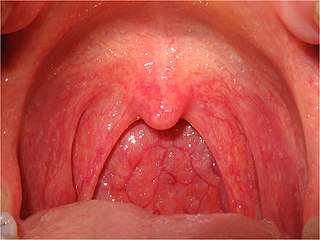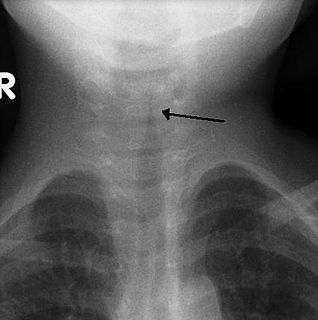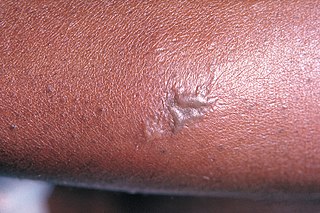Related Research Articles

Candidiasis is a fungal infection due to any type of Candida. When it affects the mouth, in some countries it is commonly called thrush. Signs and symptoms include white patches on the tongue or other areas of the mouth and throat. Other symptoms may include soreness and problems swallowing. When it affects the vagina, it may be referred to as a yeast infection or thrush. Signs and symptoms include genital itching, burning, and sometimes a white "cottage cheese-like" discharge from the vagina. Yeast infections of the penis are less common and typically present with an itchy rash. Very rarely, yeast infections may become invasive, spreading to other parts of the body. This may result in fevers along with other symptoms depending on the parts involved.

A urinary tract infection (UTI) is an infection that affects part of the urinary tract. When it affects the lower urinary tract it is known as a bladder infection (cystitis) and when it affects the upper urinary tract it is known as a kidney infection (pyelonephritis). Symptoms from a lower urinary tract infection include pain with urination, frequent urination, and feeling the need to urinate despite having an empty bladder. Symptoms of a kidney infection include fever and flank pain usually in addition to the symptoms of a lower UTI. Rarely the urine may appear bloody. In the very old and the very young, symptoms may be vague or non-specific.

An infection is the invasion of an organism's body tissues by disease-causing agents, their multiplication, and the reaction of host tissues to the infectious agents and the toxins they produce. An infectious disease, also known as a transmissible disease or communicable disease, is an illness resulting from an infection.

Pharyngitis is inflammation of the back of the throat, known as the pharynx. It typically results in a sore throat and fever. Other symptoms may include a runny nose, cough, headache, difficulty swallowing, swollen lymph nodes, and a hoarse voice. Symptoms usually last 3–5 days. Complications can include sinusitis and acute otitis media. Pharyngitis is a type of upper respiratory tract infection.

Croup, also known as laryngotracheobronchitis, is a type of respiratory infection that is usually caused by a virus. The infection leads to swelling inside the trachea, which interferes with normal breathing and produces the classic symptoms of "barking/brassy" cough, stridor, and a hoarse voice. Fever and runny nose may also be present. These symptoms may be mild, moderate, or severe. Often it starts or is worse at night and normally lasts one to two days.

Gastroenteritis, also known as infectious diarrhea and gastro, is inflammation of the gastrointestinal tract—the stomach and intestine. Symptoms may include diarrhea, vomiting and abdominal pain. Fever, lack of energy and dehydration may also occur. This typically lasts less than two weeks. It is not related to influenza, though it has erroneously been called the "stomach flu".

Tonsillitis is inflammation of the tonsils in the upper part of the throat. Tonsillitis is a type of pharyngitis that typically comes on fast. Symptoms may include sore throat, fever, enlargement of the tonsils, trouble swallowing, and large lymph nodes around the neck. Complications include peritonsillar abscess.

The Clostridia are a highly polyphyletic class of Firmicutes, including Clostridium and other similar genera. They are distinguished from the Bacilli by lacking aerobic respiration. They are obligate anaerobes and oxygen is toxic to them. Species of the class Clostridia are often but not always Gram-positive and have the ability to form spores. Studies show they are not a monophyletic group, and their relationships are not entirely certain. Currently, most are placed in a single order called Clostridiales, but this is not a natural group and is likely to be redefined in the future.

Dermatophytosis, also known as ringworm, is a fungal infection of the skin. Typically it results in a red, itchy, scaly, circular rash. Hair loss may occur in the area affected. Symptoms begin four to fourteen days after exposure. Multiple areas can be affected at a given time.

Arcanobacterium haemolyticum, formerly known as Corynebacterium hæmolyticum, is a species of bacteria classified as a gram-positive bacillus. It is catalase-negative, aerobic, beta-hemolytic, and not motile. It has been known to cause head and neck infections, pharyngitis, and sinusitis.

Pathogenic bacteria are bacteria that can cause disease. This article focusses on the bacteria that are pathogenic to humans. Most species of bacteria are harmless and are often beneficial but others can cause infectious diseases. The number of these pathogenic species in humans is estimated to be fewer than a hundred. By contrast, several thousand species are part of the gut flora present in the digestive tract.
A clostridial vaccine is a vaccine for sheep and cattle that protects against diseases caused by toxins produced by an infection with one or more Clostridium bacteria. Clostridial vaccines are often administered to pregnant ewes a few weeks before they are due to give birth, in order to give passive immunity to their lambs. Clostridial bacteria multiply rapidly in infected sheep, and produce large amounts of toxin which can cause the sheep to die within hours.

Gonorrhea, colloquially known as the clap, is a sexually transmitted infection (STI) caused by the bacterium Neisseria gonorrhoeae. Infection may involve the genitals, mouth, or rectum. Infected men may experience pain or burning with urination, discharge from the penis, or testicular pain. Infected women may experience burning with urination, vaginal discharge, vaginal bleeding between periods, or pelvic pain. Complications in women include pelvic inflammatory disease and in men include inflammation of the epididymis. Many of those infected, however, have no symptoms. If untreated, gonorrhea can spread to joints or heart valves.

Sexually transmitted infections (STIs), also referred to as sexually transmitted diseases (STDs) and the older term venereal disease, are infections that are commonly spread by sexual activity, especially vaginal intercourse, anal sex and oral sex. STIs often do not initially cause symptoms, which results in a greater risk of passing the infection on to others. Symptoms and signs of STIs may include vaginal discharge, penile discharge, ulcers on or around the genitals, and pelvic pain. STIs can be transmitted to an infant before or during childbirth, which may result in poor outcomes for the infant. Some STIs can cause infertility.
Clostridium novyi (oedematiens) a Gram-positive, endospore- forming, obligate anaerobic bacteria of the class clostridia. It is ubiquitous, being found in the soil and faeces. It is pathogenic, causing a wide variety of diseases in man and animals. It comes in three types, labelled A, B, and a non-pathogenic type C distinguished by the range of toxins they produce. Some authors include Clostridium haemolyticum as Clostridium novyi type D. C novyi is closely related to Clostridium botulinum types C and D as Yoshimasa Sasaki et al. have demonstrated by 16S rDNA sequence analysis.

White blood cells (WBCs), also called leukocytes or leucocytes, are the cells of the immune system that are involved in protecting the body against both infectious disease and foreign invaders. All white blood cells are produced and derived from multipotent cells in the bone marrow known as hematopoietic stem cells. Leukocytes are found throughout the body, including the blood and lymphatic system.

Metritis is inflammation of the wall of the uterus, whereas endometritis is inflammation of the functional lining of the uterus, called the endometrium. The term pelvic inflammatory disease (PID) is often used for metritis.
In biology, a pathogen in the oldest and broadest sense, is any organism that can produce disease. A pathogen may also be referred to as an infectious agent, or simply a germ.
Arcanobacterium phocae is a bacterial species. It is pathogenic for some sea mammals.
Trueperella pyogenes is a species of bacteria that are nonmotile, facultatively anaerobic, and gram-positive. The cells typically measure 0.5 by 2.0 μm. They appear as pleomorphic or coccoid rods. They tend to be grouped singly, or in short chains. Sometimes, they are grouped into V-shaped pairs.
References
- ↑ James, William D.; Berger, Timothy G.; et al. (2006). Andrews' Diseases of the Skin: clinical Dermatology. Saunders Elsevier. ISBN 0-7216-2921-0.